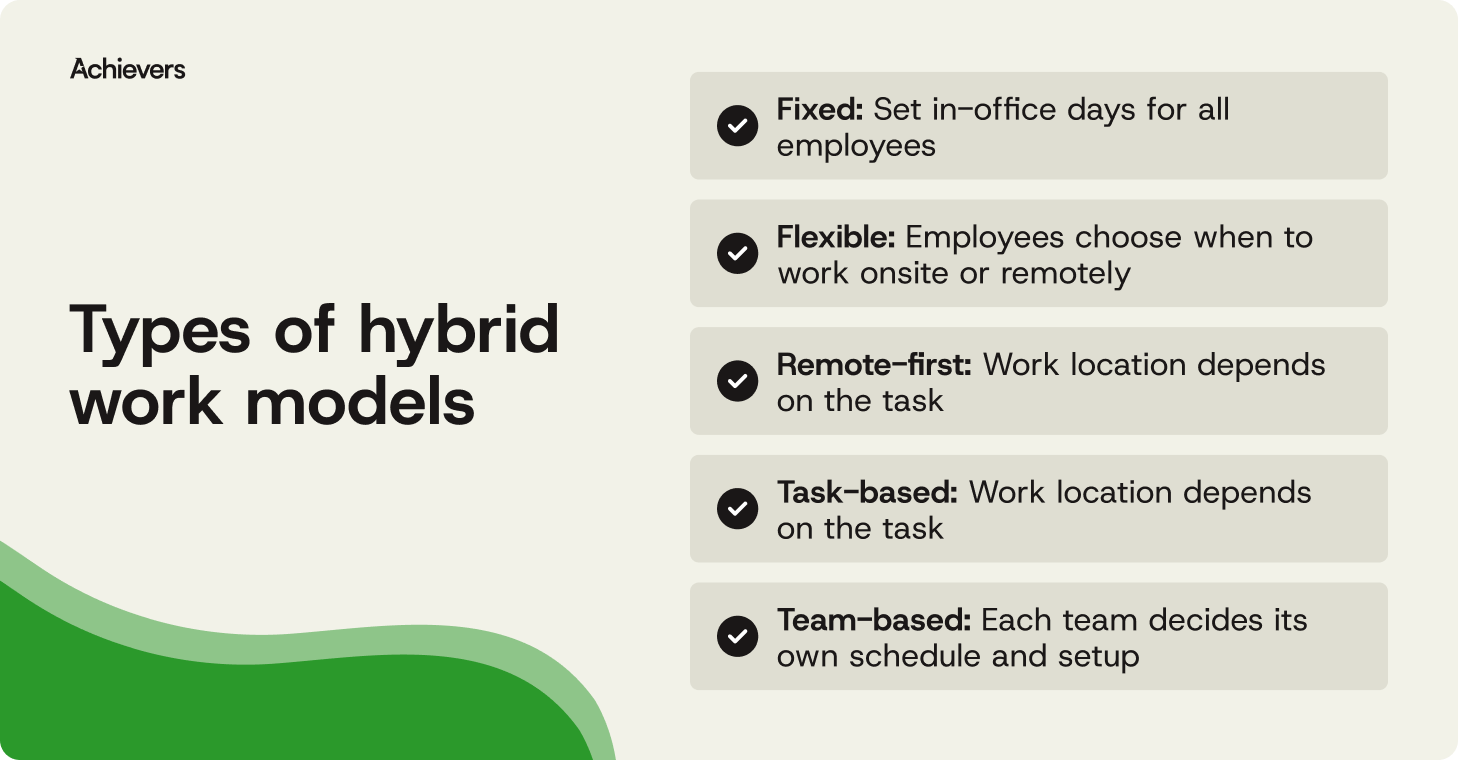Table of contents
Create a culture that means business™
Schedule a demo with an Achievers solution expert today.
Hybrid work isn’t some shiny new workplace trend anymore — it’s just how many organizations get work done. It offers the best of both worlds: employees get the flexibility of remote work, while businesses keep the connection and collaboration that comes with in-person time. Turns out, you don’t have to choose between sweatpants and strategy sessions — you can have both.
At its core, hybrid work is a simple concept: employees split their time between working on-site and working remotely. It recognizes the obvious — not every project (or person) thrives under the same conditions. Some work is better face-to-face; some gets done faster in fuzzy slippers. By making space for both, organizations can better support employees’ preferences while keeping performance and culture on track.
In this blog, we’ll break down what hybrid work really looks like, why it’s sticking around, and how organizations are making it work for their people. Because when employees feel supported — wherever they work — they show up engaged, motivated, and ready to make an impact. And that’s something every workplace can benefit from.
Why is hybrid work so popular?
Hybrid work isn’t just a passing phase — it’s the workplace’s answer to the question, “Can we do this smarter?” Spoiler: yes, we can. Employees get more balance, organizations get better business results, and no one has to fake a “Wi-Fi issue” just to get through the day. Here’s why hybrid work is here to stay — and why more organizations are leaning in:
- Flexibility employees actually care about: Hybrid work gives people what they really want: control over where and how they work. Whether it’s being home for the school drop-off or powering through projects distraction-free, employees can better balance work and life without burning out. The payoff? More energy, more engagement, and fewer Monday morning blues.
- A competitive edge in hiring and retention: Top talent knows their worth — and they know flexibility isn’t just a perk, it’s the baseline. Companies offering hybrid options send a clear message: we trust you, we respect you, and we’re not stuck in 2010. It’s a win-win for attracting great people and keeping them around.
- Productivity with purpose: Turns out, people know how they work best. Some tasks thrive on quiet focus, others on quick collaboration. Hybrid work empowers employees to choose the right setting for the job — meaning less wasted time, more meaningful progress, and a lot fewer “this could’ve been an email” meetings.
- Savings you can see: Less office space, fewer overhead costs, and shorter commutes — hybrid work doesn’t just feel good, it makes good business sense. Companies save, employees save, and the environment gets a little breather too. Everyone wins, even your budget spreadsheets.
- Built-in resilience: If the last few years taught us anything, it’s to expect the unexpected. Hybrid workplaces are naturally more adaptable and resilient, ready to pivot when life throws a curveball. The result? Steadier productivity and a workforce that’s flexible, resilient, and a lot less frazzled.
- Smarter collaboration, better culture: Hybrid work opens the door to more employee connections — whether it’s high-energy in-person brainstorms or efficient remote teamwork. By giving people options, you fuel better collaboration, fresh ideas, and a workplace culture built on trust and respect.
Hybrid work vs. remote work: what’s the difference?
Hybrid and remote work — often mentioned in the same breath, but definitely not the same thing. Let’s clear it up.
- Remote work is exactly what it sounds like: employees work entirely off-site, usually from home, with no regular visits to an office. The laptop is the office, and Slack replaces the breakroom small talk.
- Hybrid work on the other hand, keeps one foot in both worlds. Employees split their time between the office and remote locations, mixing face-to-face collaboration with the flexibility of working from home (or wherever they do their best thinking).
Both rely on digital tools to keep people connected, but hybrid work keeps the office in play — a space for connection, brainstorming, or just a break from the home office setup. It’s not either-or; it’s the best of both, designed to give employees flexibility while keeping teams feeling… well, like teams.
Exploring the different types of hybrid work
Hybrid work isn’t one-size-fits-all — and that’s exactly the point. Every organization (and every employee) has different needs, so there’s no single “right way” to do hybrid. The key is finding the model that strikes the right balance between flexibility, structure, and good old-fashioned employee productivity. Here’s a quick guide to the most common types of hybrid work setups.

Fixed hybrid model
Think of this as hybrid with a schedule. Employees split their time between the office and remote work on set days or weeks. It’s predictable, structured, and helps teams know when and where everyone will be. Great for stability… less so if you need more wiggle room.
Flexible hybrid model
This is hybrid work on employees’ terms. People choose where and when they work, within agreed guidelines. It’s a fan favorite for work-life balance, but can get tricky if your business depends on everyone being available at the same time. Clear expectations (and maybe a good calendar tool) go a long way here.
Remote-first model
Remote-first flips the script: working from home is the default, and the office is there for occasional team meetups or project sprints. Perfect for organizations with dispersed teams or those leaning into flexibility. Bonus tip: digital communication and recognition tools are a must — company culture shouldn’t stop just because you shut the office door.
Task-based hybrid model
This model keeps things refreshingly practical. Employees choose their work setting based on what they’re working on. Deep focus project? Home it is. Big group brainstorm? Office time. It’s about matching environment to task, so work gets done better, not just faster.
Team-based hybrid model
With this approach, individual teams call the shots. Managers decide the right mix of in-office and remote time, based on the unique needs of their group. It’s flexible, adaptable, and trusts teams to figure out what works best for them — because no two departments (or team leads) are quite the same.
The challenges of hybrid work (and how to handle them)
Hybrid work has a lot going for it — flexibility, engagement, and happier employees. But it’s not all smooth sailing. Shifting to a hybrid model comes with challenges that, if left unchecked, can turn flexibility into frustration. The good news? With a little planning (and the right tools), you can avoid the common pitfalls. Here’s what to watch for — and how to get ahead of it:
- Getting the right tech in place: Hybrid work only works with the right tools. Make sure everyone has solid tech, strong Wi-Fi, and access to key platforms — plus training to avoid the dreaded “you’re on mute” moment.
- Keeping your culture alive: Out of sight shouldn’t mean out of culture. Build connection through regular touchpoints, meaningful employee recognition, and moments that remind people they’re part of something bigger.
- Dodging communication breakdowns: Hybrid work can turn updates into a game of telephone. Use video, chat, and clear messaging to keep teams aligned — and invest in training so communication stays crisp.
- Avoiding burnout in disguise: Flexibility shouldn’t mean 24/7 availability. Set healthy boundaries, encourage time offline, and help managers model balance so employees can recharge and thrive.
6 ways to build a thriving hybrid work culture
A successful hybrid workplace doesn’t happen by accident. It takes the right mix of flexibility, connection, and good leadership. The good news? With a few smart moves, you can build a hybrid culture where employees feel valued, supported, and empowered to do their best work — wherever they are. Here’s how:
1. Make recognition everyone’s business
It’s easy to forget a “thank you” when you don’t bump into your co-workers in the hallway. Don’t let distance dilute appreciation. Recognition should be part of daily life — especially in hybrid workplaces. Look for a recognition platform that makes it easy to celebrate wins, integrates into employees’ everyday tools, and offers rewards people actually want (not just branded water bottles).
2. Give employees a real voice
In a hybrid world, feedback can’t be limited to in-office chats. Open up simple, accessible channels for employees to share what’s working (and what’s not). Think pulse surveys, chatbots, and tools that turn feedback into action — because listening only matters if you actually follow through.
3. Build flexible policies that work for people
Hybrid work is flexible by design — so your policies should be too. Whether it’s flex hours, compressed workweeks, or location options, give employees room to work in ways that suit their lives. One-size-fits-none policies are officially outdated.
4. Keep training fresh, flexible, and accessible
Remote work comes with new skills to master, from digital tools to time management. Offer bite-sized, self-paced learning and coaching that meets people where they are — no long-winded webinars required. Think of it as professional development that actually develops people.
5. Make connection part of the routine
Distance can lead to disengagement — but a little effort goes a long way. Mix in fun, voluntary team activities, both in-person and virtual. Listen to what employees actually enjoy (forced karaoke, probably not). It’s about building real connection, not just checking a “team bonding” box.
6. Help leaders lead for hybrid
Hybrid work needs modern leadership. That means focusing on results, not clock-watching, and learning how to communicate, coach, and connect across locations. Equip managers with the tools and training to lead hybrid teams confidently — and skip the micromanagement, it was never a good look.
Build a hybrid work culture where everyone feels connected
A thriving hybrid workplace doesn’t happen by accident. It takes more than flexible schedules — it takes real connection, recognition, and listening. Employees need to know they’re seen, heard, and appreciated, no matter where they log in from.
That’s where Achievers comes in. The right approach — and the right tools — can make all the difference. By making recognition part of daily life, offering rewards people genuinely care about, and creating simple ways to gather and act on feedback, organizations can build a workplace where everyone feels connected and valued. And when employees feel connected, culture doesn’t just survive in a hybrid world — it gets stronger.



